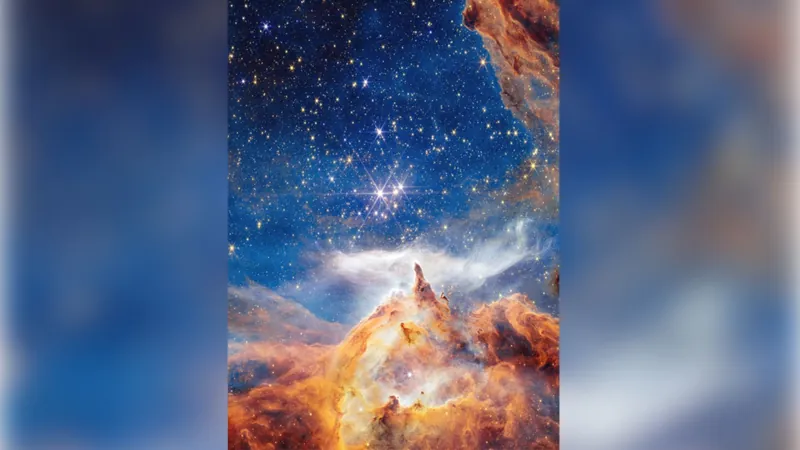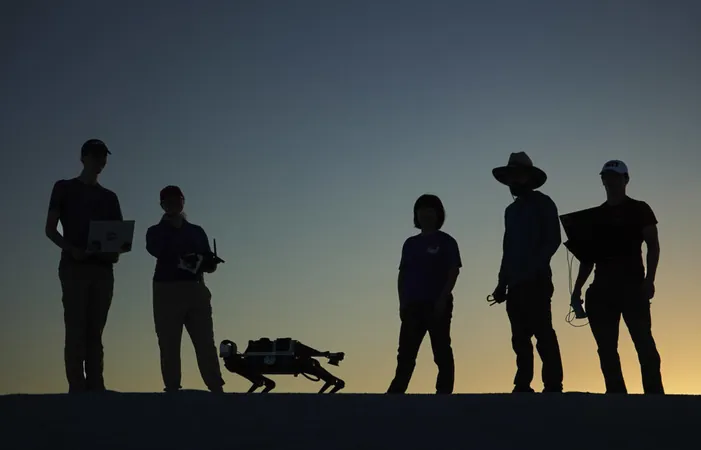
Discover the Cosmic Wonder of a Triple Star System Captured by the James Webb Space Telescope
2025-09-05
Author: Jia
Imagine a breathtaking cosmic landscape—sparkling stars hover above towering misty peaks, reminiscent of fantasy realms. This stunning scene is not a figment of imagination but a mesmerizing glimpse into our universe, captured by the James Webb Space Telescope (JWST) from 5,500 light-years away.
Enter the Lobster Nebula: A Stellar Nursery in Scorpius
Welcome to NGC 6357, also known as the Lobster Nebula, nestled within the constellation Scorpius. This magnificent nebula is a vast stellar nursery, primarily composed of molecular hydrogen gas. At its heart lies the Pismis 24 cluster, home to young, sensationally massive stars. Their dazzling ultraviolet light is rapidly eroding the gas of NGC 6357, creating a massive cavity and illuminating the cosmic architecture.
Remarkable Details from the JWST Image
The captivating image taken by JWST's Near-Infrared Camera (NIRCam) showcases only a sliver of this sprawling nebula. Here, the inner edge of the cavity bristles with jagged spikes of molecular gas—some as colossal as 5.4 light-years long! The sheer scale is monumental: within the tip of the largest spike, you could house our entire solar system—200 times over!
Meet the Stars of Pismis 24: A Triple System
Among the bright stars, the most prominent is Pismis 24-1, once regarded as the most massive star known at a staggering 300 times our sun's mass. However, revelations from the Hubble Space Telescope in 2006 uncovered that Pismis 24-1 is actually a complex triple star system. One of its stars is 66 times heavier than our sun, while the other two stars form a close binary, both weighing about 36 times as much.
A Cosmic Cycle of Creation and Destruction
All three massive stars are destined to meet explosive ends in supernovae within the next million years. Ironically, the largest molecular gas spire points directly towards Pismis 24-1, exhibiting remarkable resistance to the intense ultraviolet rays emanating from the stars. This denser gas is undergoing gravitational collapse, birthing new stars that, in turn, will one day liberate their own luminous energy.
A Galactic Canvas: The Beauty of Star Formation
The staggering scene presents a rich tapestry of countless stars, with hundreds belonging to the Pismis 24 cluster, flanked by even more in the background of NGC 6357. In the stunning false-color image, each star vibrantly reveals its type and the surrounding dust's presence while illustrating the nebula's gas composition.
The Enchantment of the Cosmic Landscape
The nebula's colors do not merely depict star types; they map the interplay of hot, ionized gas (cyan), dust particles (orange), and cooler denser molecular hydrogen (red). The densest sections are painted in deep black, showcasing their opaque nature. Completing the ethereal tableau is a wispy mist that appears to fold over the peaks of gas as it streams from the spires, energized by stellar radiation—an enchanting spectacle worthy of any space fantasy.



 Brasil (PT)
Brasil (PT)
 Canada (EN)
Canada (EN)
 Chile (ES)
Chile (ES)
 Česko (CS)
Česko (CS)
 대한민국 (KO)
대한민국 (KO)
 España (ES)
España (ES)
 France (FR)
France (FR)
 Hong Kong (EN)
Hong Kong (EN)
 Italia (IT)
Italia (IT)
 日本 (JA)
日本 (JA)
 Magyarország (HU)
Magyarország (HU)
 Norge (NO)
Norge (NO)
 Polska (PL)
Polska (PL)
 Schweiz (DE)
Schweiz (DE)
 Singapore (EN)
Singapore (EN)
 Sverige (SV)
Sverige (SV)
 Suomi (FI)
Suomi (FI)
 Türkiye (TR)
Türkiye (TR)
 الإمارات العربية المتحدة (AR)
الإمارات العربية المتحدة (AR)